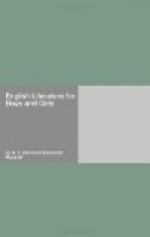BOOKS TO READ
In illustration of this chapter may be read “Edinburgh after Flodden” in Lays of the Scottish Cavaliers, by W. E. Aytoun. The best edition of the Poems of Dunbar in the original is edited by J. Small.
Chapter XXXI AT THE SIGN OF THE RED PALE
IF the fifteenth century has been called the Golden Age of Scottish poetry, it was also the dullest age in English literature. During the fifteenth century few books were written in England. One reason for this was that in England it was a time of foreign and of civil war. The century opened in war with Wales, it continued in war with France. Then for thirty years the wars of the Roses laid desolate the land. They ended at length in 1485 with Bosworth field, by which Henry VII became King.
But in spite of all the wars and strife, the making of books did not quite cease. And if only a few books were written, it was because it was a time of rebirth and new life as well as a time of war and death. For it was in the fifteenth century that printing was discovered. Then it was that the listening time was really done. Men began to use their eyes rather than their ears. They saw as they had never before seen.
Books began to grow many and cheap. More and more people learned to read, and this helped to settle our language into a form that was to last. French still, although it was no longer the language of the court or of the people, had an influence on our speech. People traveled little, and in different parts of the country different dialects, which were almost like different languages, were spoken. We have seen that the “Inglis” of Scotland differed from Chaucer’s English, and the language of the north of England differed from it just as much. But when printed books increased in number quickly, when every man could see for himself what the printed words looked like, these differences began to die out. Then our English, as a literary language, was born.
It was Caxton, you remember, who was the first English printer. We have already heard of him when following the Arthur story as the printer of Malory’s Morte d’Arthur. But Caxton was not only a printer, he was author, editor, printer, publisher and bookseller all in one.
William Caxton, as he himself tells us, was born in Kent in the Weald. But exactly where or when we do not know, although it may have been about the year 1420. Neither do we know who or what his father was. Some people think that he may have been a mercer or cloth merchant, because later Caxton was apprenticed to one of the richest cloth merchants of London. In those days no man was allowed to begin business for himself until he had served for a number of years as an apprentice. When he had served his time, and then only, was he admitted into the company and allowed to trade for himself. As the Mercers’ Company was one of the wealthiest and most powerful of the merchant companies, they were very careful of whom they admitted as apprentices. Therefore it would seem that really Caxton’s family was “of great repute of old, and genteel-like,” as an old manuscript says.*




